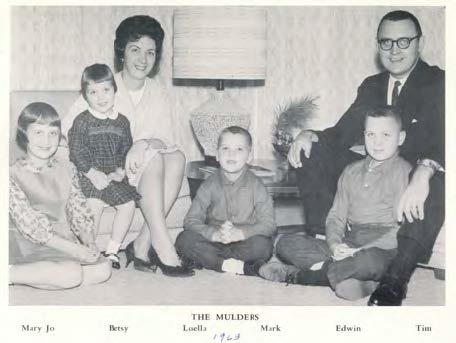

Clearing the Apple Orchard 1958
On November 7, 1957, Reverend Edwin Mulder was installed as the first pastor. The installation service was held at Trinity Reformed Church with the charge to the pastor given by Reverend Gerrit Rozeboom who was the father of Luella Mulder, Rev. Mulder’s wife.
On February 7, 1958, the congregation agreed to purchase ten acres of land which included an apple orchard on the corner of 24th Street and Graafschap Road. Approval was also given toproceed with the building of an educational building. Funding was secured by selling promissory notes to families in the church who wanted to share in this venture of faith. The mother church, Trinity Reformed Church, gave a substantial gift of $40,000 for this venture. Architects for the project were Howard Kammeraad and Rodger Stroop, both of whom were charter members with their families.

Ground Breaking 1958
The apple trees on the property were cleared by some of the men of the church. The property included the “white house” on Graafschap Road which became the first parsonage. This house was later moved to 24th Street, and consistory and youth group meetings were held in the basement which at times became flooded. Eventually the “white house” was sold and moved off the grounds.
A ground-breaking worship service was held on April 20, 1958; and the new educational building was dedicated “To the Glory of God.” The building was designed to reflect contemporary architecture for reasons of economy, function, simplicity of design, and intimate relationship to the congregation. It was designed to hold worship services as well as basketball games. The result was described as having unusual grace and inspiration. Three services were held each Sunday. By early 1959, the church had grown from 11 to 98 families with 208 communicant members, 181 baptized members, and 225 pupils in the church school. The first church directory was published in 1959.

West Side of Church looking from Graafschap to the East
In 1961 News and Views, the first all-church written communication, was published by the Senior Youth Fellowship, thus beginning a long history of church-wide communication. In 1963, Christ Memorial participated in the denomination’s Preaching, Teaching, Reaching Mission (PTR) which reflected the church’s value of evangelism and discipleship.
The vision for the church was to think outside the box and not replicate existing churches. The congregation accepted people regardless of what they did or where they were on their life journey but also held them accountable. They even allowed a person who drove a beer truck to become a member which at that time in Holland was quite radical. The church became known as the church who would take anyone. The church was a joyful, caring, celebratory congregation. The church sponsored baseball and basketball teams that played and prayed together. Church picnics were held at Smallenberg Park, Kollen Park, the Ottawa County Fairgrounds, and the Hope College Stadium. A facility was erected for Boy Scouts on the south end of the oiled parking lot, and Troop 151 met there. Many neighbors were attracted to the church because of this endeavor.
In 1962 a new parsonage was built on 24th Street east of the educational building to house Rev. Mulder and his family. The house was dedicated on December 23, 1962. This house was eventually sold and moved to 478 Graafschap Road to make room for a new sanctuary.
By 1963 the congregation was divided into “zones.” The placement of members into “zones” was an attempt to assimilate members. At the same time, every woman in the congregation was invited to join a “circle” where women met to study, pray, and fellowship. To this day, several of these “circles” still exist. On December 29, 1963, Rev. Mulder delivered his farewell sermon after having taken a call to become the Minister of Evangelism for the Reformed Church in America.
